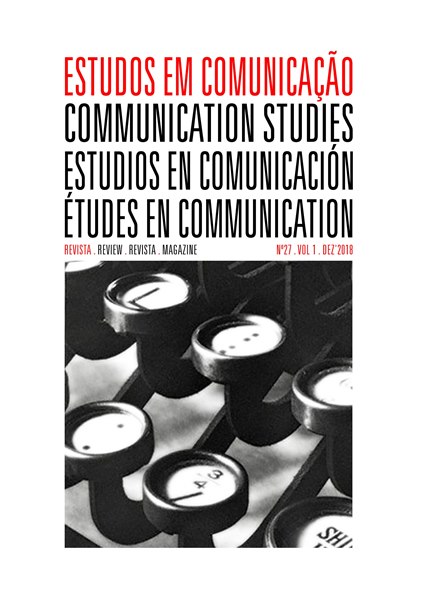Between the profane and the sacred: rites, symbols and myths in the campaign of a Brazilian football team
Keywords:
Espaço sagrado, Símbolos, Herói, Mito, FutebolAbstract
This study aims to understand the sacred from the space of a football field, the symbols evoked by the name of the stadium and, mainly, the aura of glory expressed by the name of an athlete who was part of a historical moment in the existence of the brazilian club Palmeiras that defended in the year 2015. To undertake the research, we elaborate a theoretical scope based on the postulates of Eliade, a scholar of the sacred and its manifestations. Also, due to the bias of the concepts of Jungian psychology, the imaginary of Durand and Maffesoli we weave arguments that strengthen the analysis performed. As a methodology, we use the mitochristic method of analysis proposed by Durand when conceiving the anthropological theory of image studies. This methodology allows us to analyze from the symbols the mythical narrative that is entangled in cultural objects, in this case, the question of the sacred associated with the achievements of a football team. The studies pointed to the imbrication between sacred, symbology and myths that are present in the relationship between a passionate crowd, the birth of a hero and his sacred space.
References
Allianz Park (s.d.). Disponível em www.allianzparque.com.br. Acesso em dez. 2017.
Brandão, J. de S. (1986). Mitologia grega, vol. I. Rio de Janeiro: Vozes.
Campbell, J. (1997). O herói de mil faces. 10 ed. São Paulo: Editora Pensamento.
Eliade, M. (2010). O sagrado e o profano: a essência das religiões. 2 ed. São Paulo: Martins Fontes.
Globo Esporte. (s.d.). Disponível em http://globoesporte.globo.com. Acesso em dez. 2017.
Jacobi, J. (1990). Complexo Arquétipo Símbolo na Psicologia de C. G. Jung. São Paulo: Cultrix.
Jung, C. G. (2016). O Homem e seus Símbolos . 3 ed. Especial brasileira (trad. M. L. Pinho). Rio de Janeiro: HarperCollinsBrasil.
Mark, M. & Pearson, S. C. (2001). O herói e o fora-da-lei: como construir marcas extraordinárias usando o poder dos arquétipos. São Paulo: Cultrix.
Maffesoli, M. (1996). No fundo das aparências. Rio de Janeiro: Vozes.
Moraes, H. J. P. (2016). Sob a perspectiva do imaginário: os mitos como categoria dos estudos da cultura e da mídia. In G. G. B. Flores, N. R. M. Neckel & S. M. L. Gallo (orgs), Análise do
Discurso em Rede: cultura e mídia, v.2. Campinas: Pontes.
Moraes, H. J. P. (2017). Os youtubers e as relações de identificação e projeção no imaginário infanto-juvenil contemporâneo: discussões a partir da ética da estética. Iluminuras, jan/jul, 18(44): 182-196. Porto Alegre.
Moraes, H. J. P. & Bressan, L. L. (2016). Imaginário e religiosidade na obra “Operários de Primeira Hora” de Valdemar Mazzurana e o regime noturno das imagens. REVELL – Revista de Estudos Literários da UEMS, ago, ano 7, 2(13): 42-58. Ed. Especial.
Pearson, S. C. (1991). O despertar do herói interior: a presença dos doze arquétipos nos processos de autodescoberta e de transformação do mundo. São Paulo. Editora Pensamento.
Pitta, D. P. R. (2005). Iniciação à teoria do imaginário de Gilbert Durand. Rio de Janeiro: Atlântica.
Silva, J. M. da. (2006). As tecnologias do imaginário. Porto Alegre: Sulina.
Wunerburger, J.-J. (2018). A Árvore das Imagens. (trad. A. T. M. P. Barros). Intexto, jan./abr., (41): 58-69. Porto Alegre, UFRGS. Disponível em: http://seer.ufrgs.br/index.php/intexto/artic
le/view/77402.
Downloads
Published
Issue
Section
License
Estudos em Comunicação/Communication Studies is an Open Access journal. All its content is freely available without charge to the user or his institution. Users are allowed to read, download, copy, distribute, print, search, or link to the full texts of the articles in this journal without asking prior permission from the publisher or the author. Estudos em Comunicação, by Labcom, is licensed under a Creative Commons Atribuição-NãoComercial-SemDerivações 3.0 Unported License. By submitting your work to Estudos em Comunicação/Communication studies you confirm you are the author and own the copyright, that the content is original and previously unpublished, and that you agree to the licensing terms.


